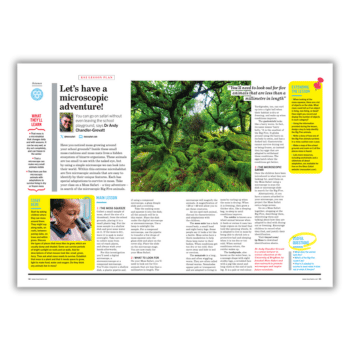Go on safari without even leaving the school playground with this KS2 microhabitat lesson from Dr Andy Chandler-Grevatt…
Have you noticed moss growing around your school grounds? Inside these small moss cushions and moss mats lives a hidden ecosystem of bizarre organisms.
These animals are too small to see with the naked eye, but by using a simple microscope we can look into their world.
Within this extreme microhabitat are five microscopic animals that are easy to identify by their unique features. Each has special adaptations to survive in moss.
Take your class on a Moss Safari – a tiny adventure – in search of the microscopic Big Five animals.
Microhabitat learning objectives
- Learn that moss is a microhabitat that changes daily and with seasons. It can be very wet, or dry out completely, and can freeze in the winter
- Understand that a microscope can make very small animals visible
- Know that there are five microscopic animals with adaptations to survive living in dry or frozen moss
Starter activity
Start by asking children where they see moss around them. They might say along walls, on roofs, between paving slabs, on trees and within grass.
Discuss the types of places that moss likes to grow, which are usually damp and shaded. Some can survive periods of bright sunlight on roofs and on walls.
Ask for descriptions of what mosses look like: small, green, furry. Then ask what moss needs to survive. Establish that moss is a plant and that it needs space to grow, light to make food, water and oxygen.
Do they think any animals live in moss?
Dr Andy Chandler-Grevatt is a senior lecturer in science education at the University of Brighton, he founded Moss Safari and does outreach to promote microscopes and inspire future scientists.











